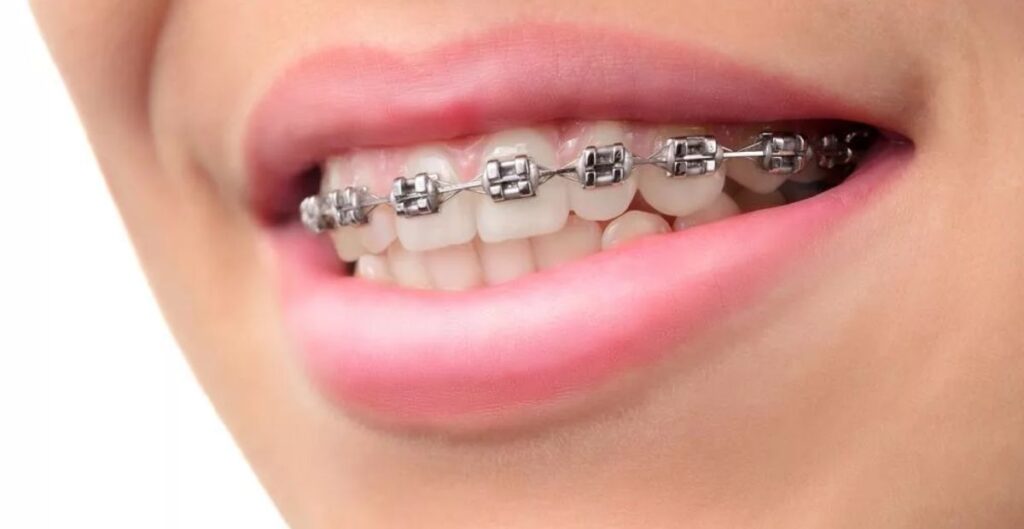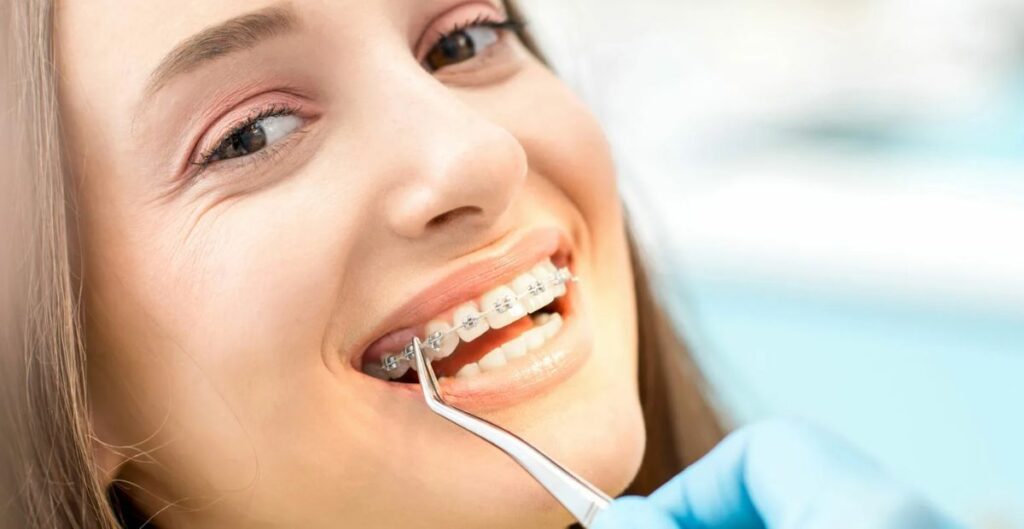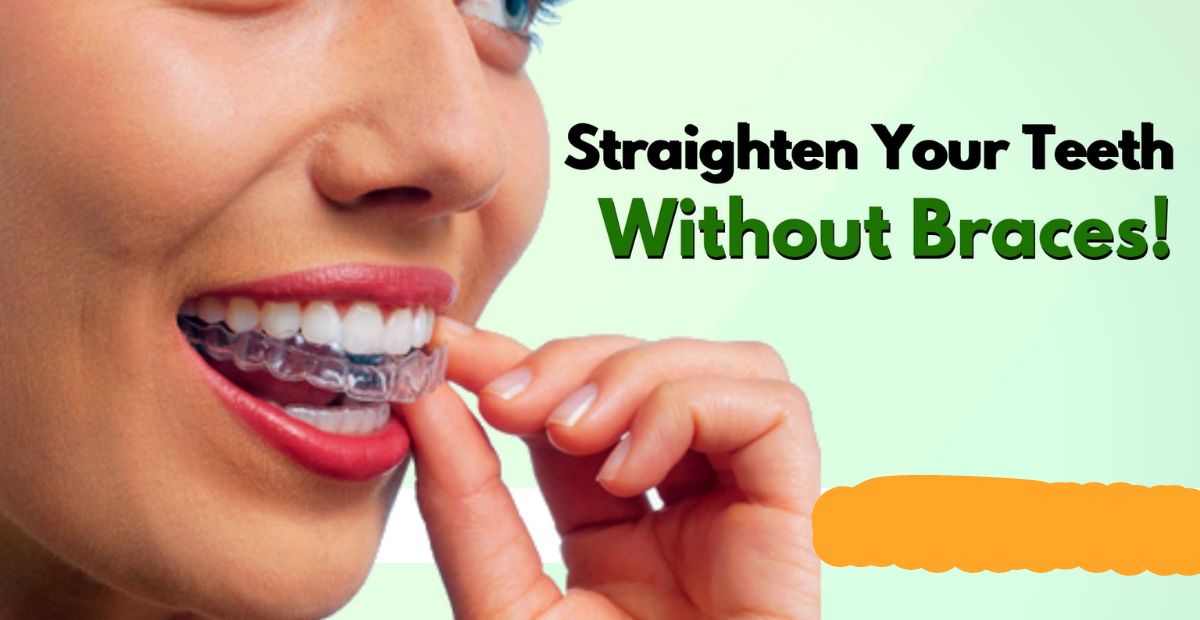Achieving a dazzling, straight smile is a dream for many, but the thought of enduring years of traditional metal braces can be daunting. The good news is that modern dentistry has evolved, offering alternative methods to straighten teeth without the need for conventional braces. In this comprehensive article, we’ll explore these innovative options, their advantages, and their limitations, empowering you to make an informed decision about your smile journey.
Is There a Way to Straighten Teeth Without Braces?
The resounding answer is yes! While traditional braces remain the gold standard and most effective method for correcting complex orthodontic issues, several alternative approaches have emerged to cater to different needs and preferences. However, it’s crucial to note that some alternatives may have limitations or risks, which we will discuss in detail.
Types of Braces

Before delving into the alternatives, let’s briefly review the traditional options for teeth straightening:
1: Metal Braces
These classic braces, consisting of metal brackets and wires, have been a trusted solution for decades. While highly effective, they can be visually apparent and may cause discomfort or irritation for some individuals.
2: Ceramic Braces
Offering a more discreet appearance, ceramic braces are made from tooth-colored materials, making them less noticeable than their metal counterparts. However, they can be more prone to staining and may be slightly more expensive.
3: Invisible Braces (Aligners)
Clear aligners, such as Invisalign, have gained immense popularity as a virtually invisible alternative to traditional braces. These clear, removable plastic trays gradually shift your teeth into the desired position. While highly convenient and aesthetically pleasing, they may not be suitable for severe orthodontic cases.
Can Retainers Straighten Teeth Without Braces?
Retainers are essential for maintaining the results achieved through orthodontic treatment, but they cannot straighten teeth on their own. Their primary purpose is to prevent your teeth from shifting back to their original positions after your braces are removed or your clear aligner treatment is complete.
Should I Try to Straighten My Teeth Without Braces at Home?
While the temptation to explore DIY methods or online hacks for straightening teeth at home may be strong, it’s essential to understand the significant risks involved.
Attempting to move your teeth without professional supervision can lead to severe consequences, such as tooth damage, gum problems, and even permanent jaw misalignment.
It’s always advisable to consult a licensed orthodontist or dentist to ensure safe and effective treatment.
Only Proven and Safe Alternative to Braces — Surgery

In cases of severe jaw misalignment or skeletal discrepancies, orthognathic surgery (jaw surgery) may be recommended as the only viable alternative to braces.
This surgical procedure involves repositioning the jaws to correct bite issues and improve facial harmony.
It’s a major undertaking that should only be considered after consulting with an orthodontist and oral surgeon, weighing the potential risks and benefits.
Also Read Related Post: Do Braces Make Your Lips Bigger? What You Need to Know
Other Ways to Improve Your Smile
While the methods discussed above focus on addressing alignment issues, there are additional options available to enhance the overall appearance of your smile:
Palatal Expanders
A palatal expander is a specialized orthodontic appliance used to gradually widen the upper jaw (palate) and create more space for crowded teeth. This treatment is often combined with braces or clear aligners to achieve optimal results.
Herbst Appliance
The Herbst appliance is a fixed oral device designed to correct severe overbites by moving the lower jaw forward. It works in conjunction with braces or aligners to establish a proper bite relationship.
Cosmetic Dentistry (Veneers, Contouring, and Bonding)
For those seeking a cosmetic enhancement without addressing underlying alignment issues, porcelain veneers, tooth contouring, and dental bonding can provide a solution. These procedures can improve the shape, color, and overall appearance of your teeth, giving you a beautiful, natural-looking smile.
Who Needs to Have Their Teeth Straightened
Orthodontic treatment is not just about aesthetics; it plays a crucial role in ensuring proper oral function and long-term dental health. Common issues that may require teeth straightening include:
- Overcrowding: When there is insufficient space in the jaw for all teeth to fit properly, leading to overlapping or crooked teeth.
- Gaps or spacing: Excess space between teeth can cause aesthetic concerns and potential bite problems.
- Overbites: When the upper teeth protrude significantly over the lower teeth, causing an improper bite and potential jaw discomfort.
- Underbites: The opposite of an overbite, where the lower teeth extend past the upper teeth, affecting both appearance and function.
- Crossbites: When the upper and lower teeth do not align properly, leading to potential jaw pain and wear on the teeth.
It’s essential to consult with an orthodontist for a comprehensive evaluation and personalized treatment plan tailored to your specific needs.
Protecting Your Healthy Smile While Wearing Braces
Regardless of the type of orthodontic treatment you choose, maintaining good oral hygiene is crucial for protecting your teeth and gums during the process. Here are some tips to keep in mind:
- Brush and floss diligently: Proper brushing and flossing techniques are essential to remove plaque and food particles that can accumulate around braces or aligners.
- Use specialized tools: Interdental brushes, floss threaders, and other orthodontic-friendly tools can help clean hard-to-reach areas around brackets or wires.
- Avoid certain foods: Sticky, hard, or crunchy foods can damage braces or aligners, so it’s best to avoid them during treatment.
- Attend regular dental check-ups: Regular visits to your orthodontist and dentist are necessary to monitor your progress and address any potential issues.
Risk Of Fake Braces For Kids
In recent years, the alarming trend of using “fake” or DIY braces, especially among teenagers and children, has raised significant concerns within the dental community. These unauthorized devices, often purchased online or made at home, pose severe risks to oral health and can cause permanent damage to the teeth, gums, and jawbone.
Attempting to straighten teeth without professional supervision and guidance can lead to various complications, including:
- Tooth root damage
- Gum disease
- Tooth loss
- Jaw misalignment
- Infection
It’s crucial for parents and guardians to educate their children about the dangers of fake braces and emphasize the importance of seeking proper orthodontic care from licensed professionals.
Types Of Underbite Correction Treatment And How To Choose

An underbite, a condition where the lower teeth protrude past the upper teeth, can cause significant functional and aesthetic problems. Fortunately, several treatment options are available to correct this issue:
- Braces or Clear Aligners: In mild to moderate cases, traditional braces or clear aligner systems like Invisalign can effectively reposition the teeth and correct the underbite.
- Jaw Surgery: For severe underbites or skeletal discrepancies, orthognathic surgery (jaw surgery) may be necessary. This procedure involves repositioning the jaws to establish a proper bite relationship.
- Combination Approach: In some cases, a combination of braces or aligners and jaw surgery may be recommended for optimal results.
When choosing the appropriate treatment, factors such as the severity of the underbite, the patient’s age, and personal preferences should be considered. Your orthodontist will conduct a thorough evaluation and recommend the most suitable option based on your specific needs.
How To Use Wax For Braces
During orthodontic treatment with braces, it’s common to experience some discomfort or irritation caused by the brackets and wires rubbing against the inside of your cheeks or lips. Orthodontic wax can provide relief and protect your mouth from these abrasions. Here’s how to use it effectively:
- Break off a small piece of wax from the container.
- Roll the wax into a small ball between your fingers to soften it.
- Locate the area of your braces causing irritation.
- Gently press the softened wax onto the offending bracket or wire, ensuring it adheres securely.
- If needed, use additional pieces of wax to cover any remaining areas of discomfort.
The wax acts as a barrier, preventing further irritation and allowing your mouth to heal. It’s important to replace the wax regularly as it wears off or gets dislodged during eating or brushing.
How Wearing Braces Headgear Affects Your Teeth Cleaning
In certain orthodontic cases, your orthodontist may recommend the use of orthodontic headgear to help correct bite issues or guide jaw growth. While highly effective, wearing headgear can present challenges when it comes to maintaining proper oral hygiene.
Here’s how headgear can impact your teeth cleaning routine and some tips to overcome these challenges:
- Accessibility: The presence of the headgear can make it more difficult to reach certain areas of your mouth with your toothbrush and floss.
- Solution: Use specialized orthodontic brushes and floss threaders designed to navigate around braces and headgear.
- Time Constraints: Removing and reattaching the headgear for each brushing and flossing session can be time-consuming.
- Solution: Develop a consistent routine and allocate extra time for your oral hygiene when wearing headgear.
- Motivation: The added effort required to maintain proper hygiene while wearing headgear can be demotivating for some patients.
- Solution: Stay focused on the end goal of achieving a beautiful, healthy smile, and celebrate small milestones along the way.
Regular professional cleanings and check-ups with your orthodontist and dentist are also essential to ensure optimal oral health during your headgear treatment.
Interesting Facts From The History Of Orthodontics
While modern orthodontic treatments have revolutionized the way we straighten teeth, the journey to perfecting these techniques has been a long and fascinating one. Here are some interesting facts from the history of orthodontics:
- Ancient Beginnings: Evidence of crude attempts at tooth straightening dates back to ancient civilizations like the Egyptians, Etruscans, and Greeks, who used materials like animal intestines and metals to shift teeth.
- The Father of Orthodontics: French dentist Pierre Fauchard is often credited as the “Father of Orthodontics.” In 1728, he introduced the “bandeau,” a horseshoe-shaped metal device used to expand the dental arches.
- The First Braces: In the early 1800s, Christophe-François Delabarre and Joachim Lafoulon introduced the first variation of modern braces, using gold or platinum wires and pins to align teeth.
- The Angle Era: Edward H. Angle, considered the “Father of Modern Orthodontics,” introduced the first classification system for malocclusions (misaligned bites) and developed advanced techniques for straightening teeth using metal bands and wires.
- The Invisalign Revolution: In the late 1990s, Invisalign’s clear aligner system revolutionized orthodontic treatment, offering a virtually invisible and removable alternative to traditional braces.
These historical milestones highlight the continuous evolution of orthodontic techniques, driven by the pursuit of improved comfort, aesthetics, and efficiency in achieving beautiful, functional smiles.
Overjet Vs. Overbite: What’s The Difference?
When discussing orthodontic issues, the terms “overjet” and “overbite” are often used interchangeably, but they refer to distinct conditions:
- Overjet: An overjet, also known as “buck teeth,” occurs when the upper front teeth protrude horizontally beyond the lower front teeth. This condition can result from various factors, including jaw misalignment, tooth size discrepancies, or thumb-sucking habits.
- Overbite: An overbite, on the other hand, refers to a vertical overlap of the upper front teeth over the lower front teeth. This vertical misalignment can cause excessive wear on the teeth, difficulty biting or chewing, and even speech problems in severe cases.
Both overjet and overbite can have functional and aesthetic implications, and addressing them may require orthodontic treatment such as braces, aligners, or, in severe cases, jaw surgery.
It’s crucial to distinguish between these two conditions and seek professional evaluation from an orthodontist to determine the appropriate treatment plan tailored to your specific needs.
Recomended This Post: Is Red a Good Braces Color?
People Also Ask (FAQ’s)
How do clear aligners work?
Clear aligners work by gradually shifting teeth into alignment using a series of custom-made, removable trays that are changed every few weeks.
Can retainers straighten teeth?
Retainers are mainly used to maintain the alignment of teeth after orthodontic treatment, but in some cases, they can help with minor tooth movement.
Are porcelain veneers a good option for teeth straightening?
Porcelain veneers are more suited for improving the appearance of teeth by covering imperfections, rather than actually straightening them. Orthodontic treatment is usually recommended for teeth straightening.
What is dental bonding and how can it help straighten teeth?
Dental bonding is a procedure where a tooth-colored resin is applied to teeth to improve their appearance. While it can help with minor cosmetic issues, it is not typically used for straightening teeth.
How does a palatal expander work?
A palatal expander is a device used to widen the upper jaw by applying gentle pressure to the upper molars. It is often used in orthodontic treatment to create more space for crowded teeth.
Is orthodontic headgear effective for straightening teeth?
Orthodontic headgear is sometimes used in combination with braces to correct bite issues and align teeth, but its effectiveness can vary depending on the individual case.
Conclusion
Achieving a beautiful, straight smile is no longer limited to traditional braces. The dental industry has evolved to offer a diverse range of alternatives, each with its own advantages and limitations. Whether you choose clear aligners, cosmetic dentistry procedures, or explore surgical options, the key is to consult with a licensed orthodontist or dentist to ensure a safe and effective treatment plan.
Remember, your oral health is paramount, and attempting DIY or unsupervised methods can have severe consequences. Embrace the journey to a confident smile, and prioritize professional guidance every step of the way.








